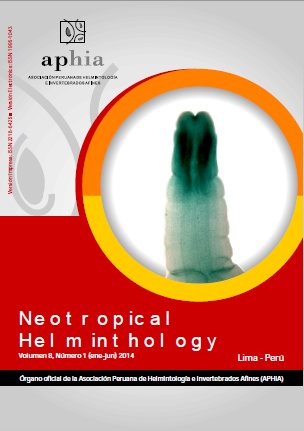FIRST REPORT OF TEMNOCEPHALA PEREIRAI (PLATYHELMINTHES, TEMNOCEPHALIDAE) ON TRACHEMYS DORBIGNI (EMYDIDAE) FROM SOUTHERN BRAZIL –A COMPLETE MORPHOLOGICAL STUDY
DOI:
https://doi.org/10.24039/rnh201481895Keywords:
freshwater turtles, Neotropic Region, taxonomy, temnocephalans, Trachemys dorbigni.Abstract
Specimens and eggs of Temnocephala pereirai Volonterio, 2010 found on Trachemys dorbigni (Duméril & Bibron, 1835), were reported for the first time extending the known geographical distribution of T. pereirai from Uruguay to southern Brazil. Sixteen turtles were collected from a dam at 'Centro Agropecuário da Palma', Universidade Federal de Pelotas (UFPel), Municipality of Capão do Leão, State of Rio Grande do Sul, Brazil. The helminthes were fixed according to our standard protocols. Juvenile and adult temnocephalans were translucent and without the red-eye pigmentation. The worms were living in the inner corners of the plastron, near the legs, together with the eggs, and in the center of the plastron. Eggs were elongated, thick-shelled, with a small and subpolar filament. The most distinctive features of this species were: 1. cirrus's introvert proximal portion with spines from top to mid-level, followed by a smooth region, extending to the introvert proximal limit; 2. vagina with strong muscular walls and a single, symmetrical sphincter; 3. vesicula intermedia unusually long; 4. small dorsolateral 'excretory' syncytial epidermal plates larger in the anterior portion; and 5. excretory pore in the anterior portion of the plate, near the internal limit. The specimens in the present work had larger body length and base diameter of the shaft than the Uruguayan specimens. Keywords: freshwater turtles - Neotropic
Downloads
Published
How to Cite
Issue
Section
License
Copyright (c) 2021 Neotropical Helminthology

This work is licensed under a Creative Commons Attribution-NonCommercial-NoDerivatives 4.0 International License.
OBJETO: El AUTOR-CEDENTE transfiere de manera TOTAL Y SIN LIMITACIÓN alguna al CESIONARIO los derechos patrimoniales que le corresponden sobre la (s) obra(s) tituladas: xxxxxxxxxxxxxxxx, por el tiempo que establezca la ley internacional. En virtud de lo anterior, se entiende que el CESIONARIO adquiere el derecho de reproducción en todas sus modalidades, incluso para inclusión audiovisual; el derecho de transformación o adaptación, comunicación pública, traducción, distribución y, en general, cualquier tipo de explotación que de las obras se pueda realizar por cualquier medio conocido o por conocer en el territorio nacional o internacional.
REMUNERACIÓN: La cesión de los derechos patrimoniales de autor que mediante este contrato se hace será a título gratuito.
CONDICIONES Y LEGITIMIDAD DE LOS DERECHOS: El AUTOR-CEDENTE garantiza que es propietario integral de los derechos de explotación de la(s) obra(s) y en consecuencia garantiza que puede contratar y transferir los derechos aquí cedidos sin ningún tipo de limitación por no tener ningún tipo de gravamen, limitación o disposición. En todo caso, responderá por cualquier reclamo que en materia de derecho de autor se pueda presentar, exonerando de cualquier responsabilidad al CESIONARIO.
LICENCIA DE ACCESO ABIERTO: El AUTOR-CEDENTE autoriza que manuscrito publicado en La Revista Neotropical Helminthology permanece disponible para su consulta pública en el sitio web https://www.neotropicalhelminthology.com/ y en los diferentes sistemas de indexación y bases de datos en las que la revista tiene visibilidad, bajo la licencia Creative Commons, en la modalidad Reconocimiento-No comercial- Sin Trabajos derivados –aprobada en Perú, y por lo tanto son de acceso abierto. De ahí que los autores dan, sin derecho a retribución económica, a la Asociación Peruana de Helmintología e Invertebrados Afines (APHIA), los derechos de autor para la edición y reproducción a través de diferentes medios de difusión.


 Numero 2 Volumen 19 - 2025 (versión Anticipada)
Numero 2 Volumen 19 - 2025 (versión Anticipada)














































